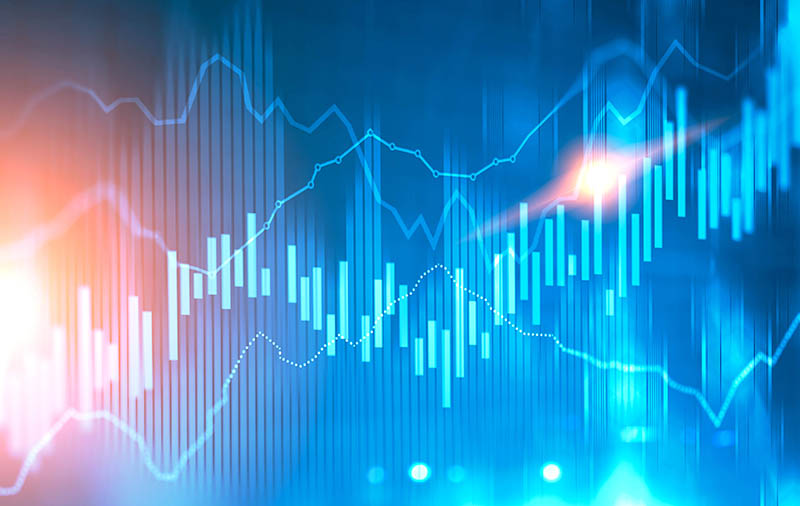
Glowing Forex like graphs and bar charts immersive interface against a blurred blue red background. Concept of stock and exchange. Business abstract infographics. Toned image double exposure mock up
(Justin Vaughn, Editor, Options Trading Report)
Stocks Score Big In A Year Marked By Wild Swings… U.S. stocks are charging toward a third consecutive year of big gains. Stock market investors had a lot to like in 2021. Even with the recent turbulence from the Omicron variant, the S&P 500 is headed toward a 27% advance in 2021. Add in the other impediment, the Delta variant, and you still have double-digit gains for all the indices. The Dow Jones Industrial Average and Nasdaq Composite have gained 19% and 22% respectively, this year, their best three-year performance since 1999. Starting with the Meme-stock and Crypto craze, 2021 has truly been a wild ride. The Market steadily climbed to multiple records, indicating investors’ renewed confidence in the face of rising inflation and record low yields on government bonds. “The last three years have been a trend line up, except for March 2020, but I don’t expect that to continue,” said Nancy Tengler, chief executive of Laffer Investments. Despite the new year, Americans are not celebrating-they are mostly miserable. The University of Michigan Index of Consumer Sentiment dropped 10% to 70.16, the lowest end-of-year reading since 2008, when the world was in the throes of a global financial crisis. Unlike that year, when the S&P 500 dropped 38%, the present index is up 27%. That’s the largest stock market gain in a year, when sentiment suffered a double-digit drop, in at least 25 years.
Next year (2022) investors will be closely monitoring ‘strain’ on the supply chain for any signs of easing, which could potentially impact consumer spending. Like 2021, analysts expect 2022 to continue building momentum that more normalized returns may lie ahead. “Investors are looking for returns, and they are willing to take on more risks than they have perhaps in the past, said Whitney Sweeney, an investment strategist at Schroders. “We continue to think there’s opportunities in equities, but they’re just going to be more muted than what we’ve seen this year,” Mrs. Sweeney adds. In bond markets, the yield on the benchmark 10-year-treasury note ticked down to 1.514%, the largest one-day decline in a week. (Yields and prices move inversely). Brent crude, the global oil benchmark, gained nine cents per barrel or 0.1% to $79.32, the highest settle in about five weeks. The Turkish lira has resumed its decline in recent days, despite the Turkish government’s experimental plan to stabilize it. “Investors and economists expect the lira to depreciate further due to high inflation and recently lowered interest rates.
One of the major inflationary forces of 2021 has been the weather. ‘Wild weather’ around the world wreaked havoc on markets for raw materials, lifting prices for everything, from energy, (electricity) housing, crops, including corn, soybeans, wheat and materials for building, (with lumber severely affected). Weather is always at play in the commodities markets. A freeze in Florida pushes up orange juice futures. A blizzard in Chicago boosts natural gas prices. A bumper crop floods the market, but this year the weather was steadily extreme, and often in ways that sent commodity prices higher -across the board. “Weather is probably the biggest factor of higher prices,” said Craig Turner, senior commodities broker with StoneX Financial. Drought struck North America, drying up hydropower in the West. One big hydropower station in Northern California had to be shut down completely when Lake Oroville dropped beneath the water level needed to generate electricity. Natural gas and coal were burned to cover the shortfall, driving up prices. The hottest June in North America kept air conditioners humming and fuel prices climbing. Wildfires broke out in bone-dry forests of the Pacific Northwest forcing the closure of many British Columbia sawmills, with wood prices surging to record highs. When commodities broker Tommy Grisafi toured North Dakota to size up wheat conditions in the spring, he found the wheat crop plagued by grasshoppers that thrive in dry conditions. More than 1.2 million acres planted with spring wheat were never harvested, adding to the 44% drop in production. The Canadian prairie was severely parched also, with production falling 50%. Natural gas futures hit $6.31 on October 5, the highest price in more than a decade. Weather and inflation had tremendous effects on the U.S. economy in 2021.
RUMBLINGS ON THE STREET
Andrew Cole, head of multi assets in London at Pictet Asset Management, WSJ “Inflation is widely expected to peak, if not in the first quarter, the first half of next year. You might have to wait until the second half of next year for central banks to relax.”
Mark Zandi, chief economist at Moody’s Analytics WSJ Mr. Zandi downgraded his first quarter U.S gross domestic product forecast to 2.2% growth from 5.2% as he “can see the economic damage mounting going into the first quarter.” He added that softer spending on travel and concentrations of sporting events and Broadway shows are due to the disruptive Covid-19 Outbreaks. He initially expected economic growth of 6.1% headed into the third quarter; in the end the economy expanded at a 2.3% pace from July to September. “Broadly speaking each new wave is going to do a little less damage than the previous waves,” said Mr. Zandi. “Healthcare providers have gotten better at treating the virus and businesses are getting better at adjusting.”
David Rosenberg, Rosenberg Research, founder, Barron’s “Yes, we are in a huge–perhaps unprecedented–equity market bubble, and it keeps getting bigger and bigger.”
Stacy Rasgon, an analyst at Bernstein, Barron’s “Intel’s problems have ‘been building for 10 years. And it’s going to take five to 10 years to fix it.’ ”
Dr. John Perelmam, on Barrons.com “The public has to realize that [Covid-19] is a never-before-precisely-seen phenomenon.”






